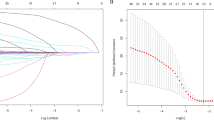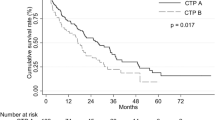Abstract
Background
Two serology-based scoring models for prognostication of patients with hepatocellular carcinoma (HCC), the BALAD and BALAD-2 models, were applied to a Japanese cohort of a nationwide follow-up survey of HCC. The ability of these models to predict the progression of HCC and the deterioration of liver function and to assess prognosis was evaluated.
Methods
BALAD and BALAD-2 scores were calculated in 24,029 patients from a cohort of Japanese nationwide survey based on the serum levels of five markers (bilirubin, albumin, lens culinaris agglutinin-reactive alpha-fetoprotein, alpha-fetoprotein, and des-gamma-carboxy prothrombin) measured at the time of HCC diagnosis. The associations of these scores with the progression of HCC and liver function and with survival rates were analyzed.
Results
There were good correlations between BALAD and BALAD-2 scores and the progression of HCC and Child–Pugh class. Both scores accurately categorized patients into risk groups with different survival rates. BALAD-2 showed superior discrimination of patient survival compared with the original BALAD.
Conclusions
Serology-based scoring models for prognostication, especially the BALAD-2 model, were useful for staging and prognostication of survival in a cohort of Japanese patients with HCC from a nationwide survey.



Similar content being viewed by others
References
Okuda K, Ohtsuki T, Obata H, et al. Natural history of hepatocellular carcinoma and prognosis in relation to treatment. Study of 850 patients. Cancer. 1985;56:918–28.
The Cancer of the Liver Italian Program (CLIP) Investigators. A new prognostic system for hepatocellular carcinoma: a retrospective study of 435 patients. Hepatology. 1998;28:751–5.
Chevret S, Trinchet J-C, Mathieu D, et al. A new prognostic classification for predicting survival in patients with hepatocellular carcinoma. J Hepatol. 1999;31:133–41.
Llovet JM, Bru C, Bruix J. Prognosis of hepatocellular carcinoma: the BCLC staging classification. Semin Liver Dis. 1999;19:329–38.
Leung TW, Tang AM, Zee B, et al. Construction of the Chinese University Prognostic Index for hepatocellular carcinoma and comparison with the TNM staging system, the Okuda staging system, and the Cancer of the Liver Italian Program staging system: a study based on 926 patients. Cancer. 2002;94:1760–9.
Kudo M, Chung H, Haji S, et al. Validation of a new prognostic staging system for hepatocellular carcinoma: the JIS score compared with the CLIP score. Hepatology. 2004;40:1396–405.
Toyoda H, Kumada T, Osaki Y, et al. Staging hepatocellular carcinoma by a novel scoring system (BALAD score) based on serum markers. Clin Gastroenterol Hepatol. 2006;4:1528–36.
Fox R, Berhane S, Teng M, et al. Biomarker-based prognosis in hepatocellular carcinoma: validation and extension of the BALAD model. Br J Cancer. 2014;110:2090–8.
Berhane S, Toyoda H, Tada T, et al. Role of the GALAD and BALAD-2 serologic models in diagnosis of hepatocellular carcinoma and prediction of survival in patients. Clin Gastroenterol Hepatol. 2016;14:875–86.
Makuuchi M, Kokudo N, Arii S, et al. Development of evidence-based clinical guidelines for the diagnosis and treatment of hepatocellular carcinoma in Japan. Hepatol Res. 2008;38:37–51.
The Liver Cancer Study Group of Japan. The general rules for the clinical and pathological study of primary liver cancer (English Ed.). 5th ed. Tokyo: Kaneraha & Co. Ltd; 2009.
Tateishi R, Yoshida H, Shiina S, et al. Proposal of a new prognostic model for hepatocellular carcinoma: an analysis of 403 patients. Gut. 2005;54:419–25.
Akaike H. Information theory as an extension of the maximum likelihood principle. In: Petrov BN, editor. Second international symposium on information theory. 1973.
Taktak AFG, Eleuteri A, Lake SP, et al. (2007) Evaluation of prognostic models: discrimination and calibration performance. In: Proceedings of the 3rd International Conference on Computational Intelligence in Medicine and Healthcare
Pugh RNH, Murray-Lyon IM, Dawson JL, et al. Transection of the oesophagus for bleeding oesophageal varices. Br J Surg. 1973;60:646–9.
International Union Against Cancer (UICC). Liver. In: Sobin LH, Wittekind CH, editors. TNM classification of malignant tumours. 6th ed. New York: Wiley; 2002. p. 81–3.
Vauthey JN, Lauwers GY, Esnaola NF, et al. Simplified staging for hepatocellular carcinoma. J Clin Oncol. 2002;127:603–8.
Kawata S, Murakami T, Kim T, et al. Multidetector CT: diagnostic impact of slice thickness on detection of hypervascular hepatocellular carcinoma. Am J Roentgenol. 2002;179:61–6.
Ichikawa T, Erturk SM, Araki T. Multiphasic contrast-enhanced multidetector-row CT of liver: contrast-enhancement theory and practical scan protocol with a combination of fixed injection duration and patients’ body-weight-tailored dose of contrast material. Eur J Radiol. 2006;58:165–76.
Kim HD, Lim YS, Han S, et al. Evaluation of early-stage hepatocellular carcinoma by magnetic resonance imaging with gadoxetic acid detects additional lesions and increases overall survival. Gastroenterology. 2015;148:1371–82.
Toyoda H, Kumada T, Kiriyama S, et al. Impact of surveillance on survival of patients with initial hepatocellular carcinoma: a study from Japan. Clin Gastroenterol Hepatol. 2006;4:1170–6.
Toyoda H, Kumada T, Osaki Y, et al. Role of tumor markers in assessment of tumor progression and prediction of outcomes in patients with hepatocellular carcinoma. Hepatol Res. 2007;37:S166–71.
Nagaoka S, Yatsuhashi H, Hamada H, et al. The des-γ-carboxy prothrombin index is a new prognostic indicator for hepatocellular carcinoma. Cancer. 2003;98:2671–7.
Nouso K, Kobayashi Y, Nakamura S, et al. Prognostic importance of fucosylated alpha-fetoprotein in hepatocellular carcinoma patients with low alpha-fetoprotein. J Gastroenterol Hepatol. 2011;26:1195–200.
Toyoda H, Kumada T, Kiriyama S, et al. Prognostic significance of simultaneous measurement of three tumor markers in patients with hepatocellular carcinoma. Clin Gastroenterol Hepatol. 2006;4:111–7.
Johnson PJ, Berhane S, Kagebayashi C, et al. Assessment of liver function in patients with hepatocellular carcinoma: a new evidence-based approach-the ALBI grade. J Clin Oncol. 2015;33:550–8.
Johnson PJ, Pirrie SJ, Cox TF, et al. The detection of hepatocellular carcinoma using a prospectively developed and validated model based on serological biomarkers. Cancer Epidemiol Biomark Prev. 2014;23:144–53.
Author information
Authors and Affiliations
Consortia
Corresponding author
Ethics declarations
Conflict of interest
The authors declare that they have no conflict of interest.
Electronic supplementary material
Below is the link to the electronic supplementary material.
535_2017_1321_MOESM2_ESM.pptx
Supplementary material 2 (PPTX 221 kb) Supplementary figure S1. Selection flowchart of the study patients in a cohort of a Japanese nationwide survey of patients with HCC. Supplementary figure S2. Survival rates of patients with intermediate BALAD scores. A) Comparison of survival rates of patients with BALAD score 3 between patients with 1 elevated tumor marker (deteriorated liver function predominant) and patients with 3 elevated tumor markers (tumor progression predominant). No significant difference was found (p = 0.3873). B) Comparison of survival rates of patients with BALAD score 2 between patients with 0 elevated tumor marker (deteriorated liver function predominant) and patients with 2 elevated tumor markers (tumor progression predominant). No significant difference was found (P = 0.6990). Supplementary figure S3. Survival rates of patients with hepatocellular carcinoma (HCC) after diagnosis by original BALAD scores evaluated by serum levels of the following measured at the diagnosis of HCC: ALB, T-Bil, AFP, AFP-L3, and DCP. A) Patients with hepatitis B virus (HBV) infection; B) Patients with hepatitis C virus (HCV) infection; C) Patients without hepatitis virus infection (non-HBV/HCV). Supplementary figure S4. Survival rates of patients with hepatocellular carcinoma (HCC) who undergone A) curative, B) intermediate, and C) palliative or no treatment after diagnosis by original BALAD scores evaluated by serum levels of the following measured at the diagnosis of HCC: ALB, T-Bil, AFP, AFP-L3, and DCP. Supplementary figure S5. Survival rates of patients with hepatocellular carcinoma (HCC) after diagnosis based on Japan Integrated Staging scores evaluated at the diagnosis of HCC. Dotted lines, 95% confidence intervals (CIs)
Rights and permissions
About this article
Cite this article
Toyoda, H., Tada, T., Johnson, P.J. et al. Validation of serological models for staging and prognostication of HCC in patients from a Japanese nationwide survey. J Gastroenterol 52, 1112–1121 (2017). https://doi.org/10.1007/s00535-017-1321-6
Received:
Accepted:
Published:
Issue Date:
DOI: https://doi.org/10.1007/s00535-017-1321-6




